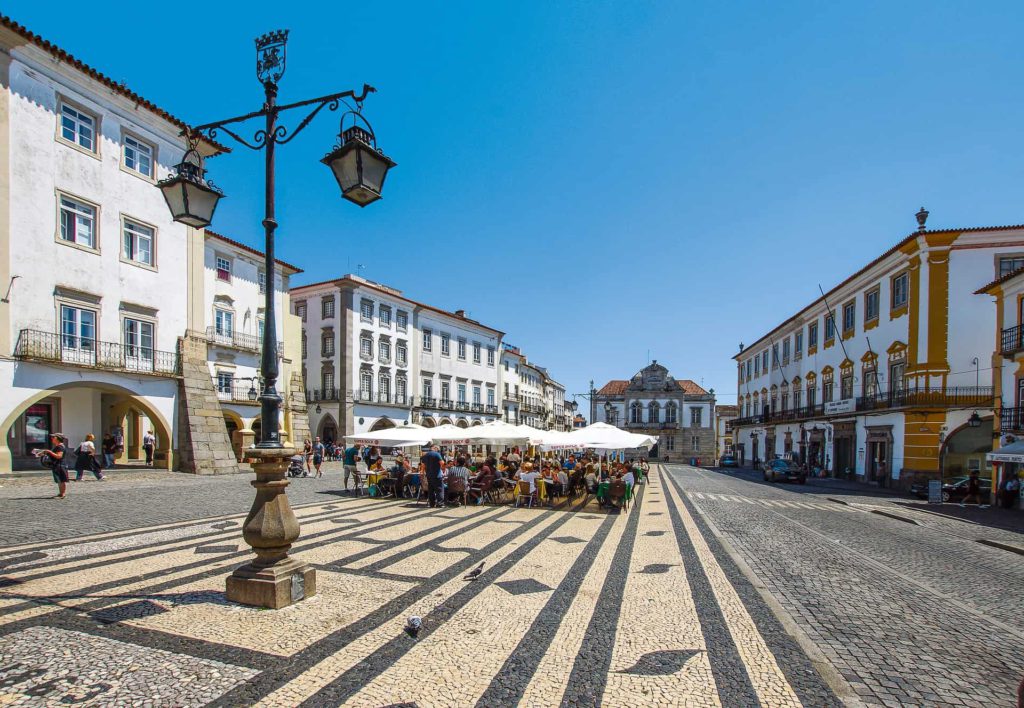Student Tour to Evora Portugal
Évora is a Portuguese city, district capital. It is located in the Alentejo region, the intermunicipal community of Central Alentejo, and has a population of 56,596 inhabitants (2011.) Évora is the only Portuguese city that is a member of the Network of Oldest Cities in Europe.
Its municipal area is one of the largest in Portugal, with 1,307.08 km², 2 subdivided into 19 parishes. The city limits to the north with the municipality of Arraiolos, to the northeast with Estremoz, to the east with Redondo, to the southeast with Reguengos de Monsaraz, to the south with Portel, to the southwest with Viana do Alentejo and to the west with Montemor-o-Novo. It is the seat of the District and former diocese and ecclesiastical metropolis (Archdiocese of Évora).
Its well-preserved historical center is one of the richest in monuments in Portugal, which gives it the name of “City-Museum”. In 1986, the historic center of the city was declared a World Heritage Site by Unesco.
The landscape of the Évora region is characterized by extensive cereal cultivation, with patches of grassland and cork and oak forests. Vineyards, olive groves and rice fields are also part of the landscape.
The Évora region has a rich history that dates back more than two thousand years in the past, as evidenced by nearby megalithic monuments such as the Dolmen de Aguiar (“Anta do Zambujeiro”) and the Crómlech de los Almendros. Some Neolithic settlements flourished in the region, of which the closest was located in Alto de São Bento. Another town with these characteristics was the Giraldo Castle, continuously inhabited from the third millennium to the first millennium BC, which was subsequently sporadically occupied during medieval times. Archaeological excavations, however, have not shown until now whether the area of the current city was inhabited before the arrival of the Romans.
For the city of Évora, the extinction of the prestigious university in 1759 (which would be restored about two centuries later), following the expulsion of the Jesuits from the country by order of the Marquis of Pombal, was a strong blow. 17th and 18th centuries important buildings of the city were renovated or built from scratch in Mannerist style. In the heritage of Évora stands out the baroque presbytery of the cathedral, designed by the architect Johann Friederich Ludwig, and many altars and tile panels that cover the interior of the churches and the University.
In the sequence of the first French invasion of Portugal, commanded by General Junot, the Battle of Évora occurred on July 29, 1808, during the Peninsular War. The Portuguese army, in numerical inferiority, tried to stop a French-Spanish division commanded by Louis Henri Loison, but was defeated. Led by the Napoleonic general Loison, known as Maneta (“with one hand”), the French broke into in the city, which was defended by Portuguese and Spanish soldiers, militiamen and armed citizens. Bursting into the city, the attackers killed combatants and non-combatants alike, before looting the site.
Braganza dynasty
In the 19th century, Évora went through many urban transformations, some of dubious quality. In Giraldo square, the prison and the old Manueline town hall were demolished and the Banco de Portugal building was built in its place, while the town hall headquarters was moved to the Palace of the Counts of Sortelha, in Sertorio Square. The Convent of San Francisco was also demolished (the Gothic church was saved) and a new residential area and a market were built in its place, instead of formerly occupied by the Convent of Santo Domingo, the García de Resende Theater (c. 1892). The medieval walls were largely preserved, but of the old entrances only the Avis Gate remained. In the 20th century a ring road was built around the perimeter of the wall, which helped in its preservation.
Enjoy this Student Tour to Evora in Portugal with Iberinbound Travel expertise.
The most outstanding monuments are the former archbishop’s palace, now converted into a regional museum, and the cathedral, built in 1186 and originally in the Romanesque style, but rebuilt in the Gothic style in the 15th century. The city also has architectural remains from the Roman era, such as a 1st century temple, known as the Temple of Diana.
Iberinbound Travel, incoming travel agency in Spain and Portugal iberinbound@iberinbound.com We are leaders in Group tours if they are Pilgrimage, Educational, Students, Leisure, ad-hoc groups, Shorex, MICE.

